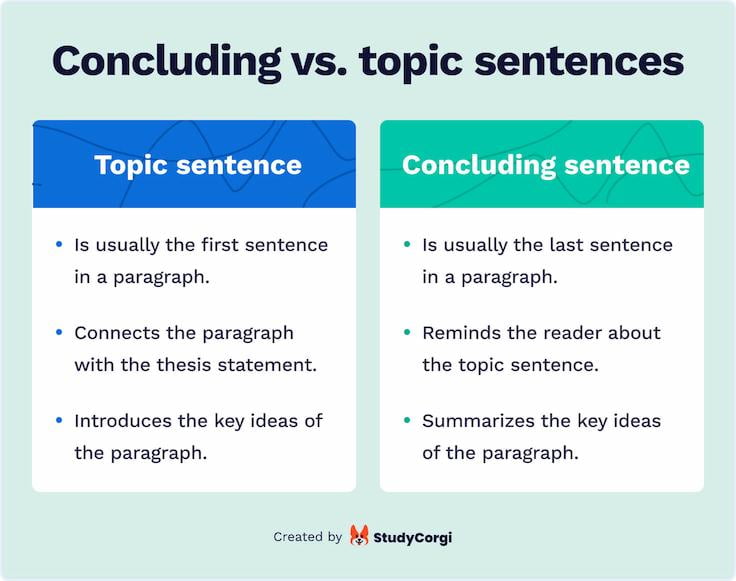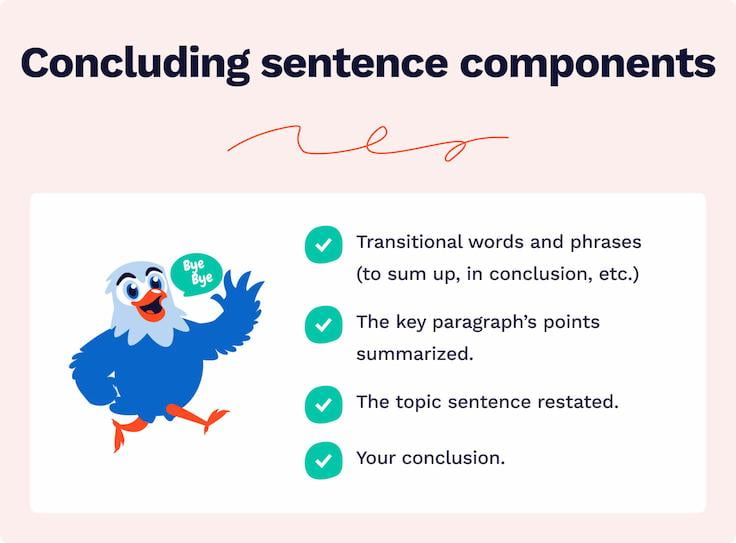📝 Concluding Sentence Maker – How to Use It?
You’ve been writing a concluding sentence in a paragraph for half an hour to no avail. We know; we’ve been there. Let us help you:
- Type in the main issue (that will become the sentence subject).
- Add your conclusion about the problem (that will be the predicate).
- List the reasons behind such a conclusion (use a separate line for each).
- Mention the location and timing (optional).
- Press “Generate” and enjoy the result for free!
If you don’t like it, check the examples in the concluding sentence generator to see how it works.
🤔 What Is a Concluding Sentence?
The term “concluding sentence” denotes:
- The last sentence of a stand-alone paragraph (for brief statements)
- The last sentence of the main body section.

In either case, the take-home phrase for the reader should perform several functions:
- Signal that here’s the end of the paragraph;
- Remind about the topic or introduction sentence;
- Summarize the main ideas listed in the section.
Concluding Sentence Starters
Conclusion sentence starters are transitional words that link it to everything mentioned above or indicate that here comes the end of the paragraph.
Check the brief list of examples:
- All in all;
- Therefore;
- In other words;
- In any event;
- In short;
- To sum up.
🆚 Concluding Sentence Vs. Topic Sentence
These friends go hand in hand and ring the paragraph turning it into a cohesive statement rather than a series of random phrases.

The topic sentence outlines the idea, and the concluding one summarizes its analysis. As you can see, neither can exist independently from the other. Follow these recommendations while formulating both:
| Concluding Sentence | Topic Sentence |
|---|---|
| Restates the big idea | Introduces the big idea |
| Summarizes the examples | Announces the examples |
| Transitions to the following paragraph | Is rarely related to the previous paragraph |
| Never introduces new thoughts | States a new thought |
| Fit into a single sentence | |
| Never provide specific details, examples, or considerations. Save those for the in-between sentences. | |
| Contain the message of the paragraph | |
📍 How to Write a Concluding Sentence in a Paragraph
There are several key elements to a concluding sentence.

Concluding Sentence Elements
- Transitional phrases provide a sense of closure (in conclusion), summarize (to sum up), or infer (therefore).
- The main points mentioned in the paragraph should be summarized.
- A restated topic sentence usually becomes the first part of the concluding sentence.
- A final opinion about the topic provides the reader with a takeaway message and is particularly critical in an argumentative essay.
All these elements are optional and can be used or skipped, depending on your purposes.
Ways to Conclude a Paragraph
Here’s an example of a standard main-body paragraph with a topic sentence (in italics).
Global warming is a considerable problem for today’s businesses in almost all industries. For example, coastal areas must be adapted to the shifted shorelines, forcing restaurants and hotels to close or move their businesses. New trends in the customers’ and investors’ activity urge the companies to ensure sustainable production. Moreover, the increasingly scarce natural resources weaken the production capacities.
There are several ways to conclude the above paragraph:
| ❓ How to conclude? | 👀 Example | 💬 Explanation |
|---|---|---|
| Close the argument | All in all, climate change has created numerous obstacles for entrepreneurs. | This variant only reiterates the topic sentence without suggesting any new ideas. |
| Summarize the examples | In general, service and production sectors face increased capital and operational costs due to climate change. | This concluding sentence rewords the topic sentence, specifying the industries and suggesting the economic results of the mentioned problems. |
| Suggest a logical inference | Therefore, we are in the doorway to a new way of doing business. | This variant suggests the final opinion but does not restate the topic sentence. |
📝 Do’s & Don’ts of Concluding Sentence Writing
If you have already written a concluding sentence and wish to check its appropriateness, here’s a brief checklist:
🟢 DO:
- Reiterate what you’ve said in the topic sentence
- Use more specific and detail-oriented synonyms of the words in the topic sentence.
- Make the conclusion grammatically different from the topic sentence.
- Wrap up the paragraph and give a sense of closure.
- Using linking words to mark the end of the section.
🔴 DON’T:
- Use the wording you already used in the topic sentence.
- Start a new topic.
- Focus on a narrower idea than those described in the paragraph (you can start it in the following line if necessary).
-
Use sentence starters like:
- So now you know,
- That’s why,
- That is what I understood from,
- These are non-academic speech formulas.
Thank you for reading this article! If you want to polish your assignment quickly and efficiently, you can try our free writing tools.
❓ Concluding Sentence Maker FAQ
❓ What Is a Concluding Sentence?
A concluding sentence is the culmination of a stand-alone or in-text paragraph. It restates the topic sentence in a new light and provides a sense of completeness. It also reconsiders the reasoning that went in between these two sentences. Sometimes, it may start an argument that will appear in the following paragraph.
❓ How to Write a Good Concluding Sentence?
- Begin with a concluding sentence starter or speech formula.
- Reiterate the topic sentence.
- Consider integrating the new information you gave in the paragraph into the reiterated topic sentence.
- Unite all the above and make sure the argument is closed.
- If nothing helps, use a concluding sentence generator.
❓ How to Write a Concluding Sentence for a Paragraph?
- Think about what you would like your reader to remember from the paragraph.
- Re-read the topic sentence.
- Make a mental list of the arguments or examples in the paragraph.
- Reword the topic sentence, adding the list from the previous point.
- Use a conclusion sentence generator.
❓ How to Start a Concluding Sentence?
The best way to start a concluding sentence is to use one of the appropriate speech formulas. Depending on the situation, they may:
- Give a sense of closure: in conclusion, all in all, finally, lastly;
- Summarize: to sum up, overall, in general;
- Infer: for this reason, as a result, therefore.